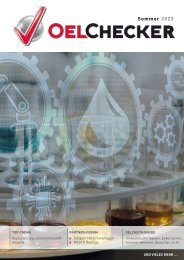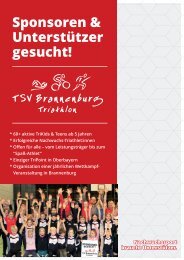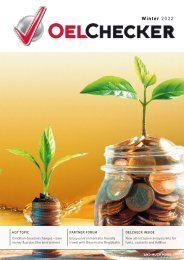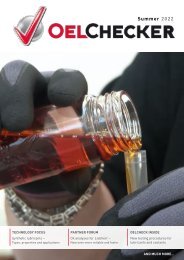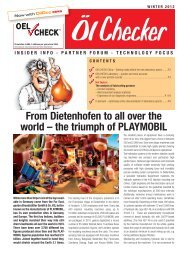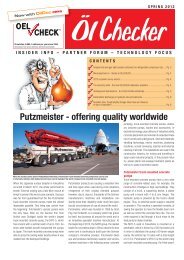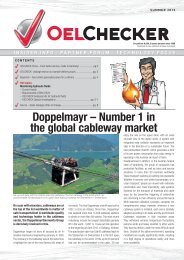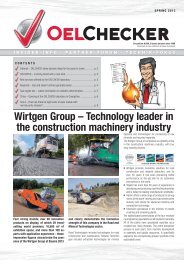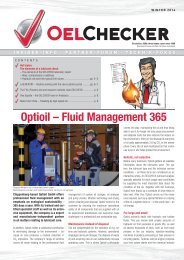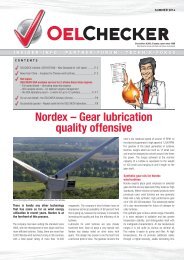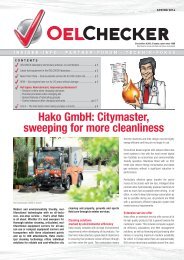OELCHECKER - Summer 2012
> Prokon wind turbines – optimum service and secure earnings > OELCHECK laboratory in the "workbench of the world" domain > The rappers from the OELCHECK alpine pastures > Optimised technology and perfect service for gas engines – August Storm > Hot Topics: > Viscosity – the single most important physical characteristic of any oil > Question time: Limit values > and much more...
> Prokon wind turbines – optimum service and secure earnings
> OELCHECK laboratory in the "workbench of the world" domain
> The rappers from the OELCHECK alpine pastures
> Optimised technology and perfect service for gas engines – August Storm
> Hot Topics:
> Viscosity – the single most important physical characteristic of any oil
> Question time: Limit values
> and much more...
Create successful ePaper yourself
Turn your PDF publications into a flip-book with our unique Google optimized e-Paper software.
SUMMER <strong>2012</strong><br />
IMPRINT<br />
We have been using OELCHECK lubricant<br />
analyses for several years now<br />
and couldn’t manage without them.<br />
But why do you not indicate any “limit<br />
values” in your laboratory reports, in<br />
particular for wear metals? You only<br />
give the values for the current sample<br />
and previous investigations. If limit<br />
values were also provided, we could<br />
draw conclusions on the condition of<br />
the oil or the machine even faster ourselves<br />
and with greater accuracy.<br />
OELCHECK:<br />
The suggestion to provide the limit, threshold<br />
and warning values for wear metals or even for<br />
lubricant additives was a hot topic in our last<br />
customer survey. But unfortunately we cannot<br />
grant this wish as limit values, which are independent<br />
of time, do not reflect application-specific<br />
scenarios. In conclusion, every machine,<br />
with its own operational conditions, needs to be<br />
considered on an individual basis. For this, not<br />
only do we have to take into account the machine<br />
type, the actual lubricant used, its maintenance<br />
and the amount to be filled – above all<br />
its operating time as well as environmental conditions<br />
influence threshold limit consideration.<br />
In the case of complex systems, this is often<br />
even more complicated. This is because some<br />
manufacturers purchase components from<br />
alternate suppliers which may have the same<br />
features but are made from different materials.<br />
Also, if partial-flow filters have been installed,<br />
large amounts of oil have been refilled or additives<br />
have been added retrospectively, fixed<br />
limit values are no longer helpful.<br />
Limit values with corresponding limitations<br />
are published only in a handful of cases by<br />
machine and engine manufacturers. Therefore,<br />
with the help of our own database, which<br />
QUESTION TIME:<br />
contains over two million samples, we decided<br />
to make the complex topic more transparent<br />
for our diagnosis engineers. Meanwhile, for assessing<br />
the examined samples, we use internal<br />
wear threshold values for over 150,000 different<br />
machines. In the event of a deviation or change<br />
in a single component of a device, we create a<br />
new database. For this specific machine type,<br />
however, we won’t have threshold values until<br />
we have conducted at least 50 analyses for the<br />
same or a similar type of machine.<br />
Because even though such detailed knowledge<br />
on limits for wear metals may be available, it is<br />
not sufficient for assessing an actual sample.<br />
This is where our know-how comes into play because<br />
all values must also be considered together<br />
as a whole. A diagnosis that is based solely<br />
on comparing laboratory data that has just been<br />
established with limit values can quickly become<br />
misleading. Values will look different if they are<br />
assessed after 20, 200, 2,000 or 20,000 hours.<br />
In order to rule out the time-related risk, for example,<br />
we do not publish threshold values as a<br />
matter of principle.<br />
How complex the contexts can be overall is illustrated<br />
in the following examples:<br />
• Not all elements and metals detected in a<br />
sample necessarily suggest wear. Some (e.g.<br />
copper) can also be additives that are found<br />
in lubricants. First of all, a comparison of the<br />
used oil values with the additives from the<br />
fresh oil, together with the IR spectrum, gives<br />
an indication of additive decomposition.<br />
Perhaps just a single active component from<br />
the whole additive package changed by forming<br />
a new type of bond with wear particles.<br />
• It is essential that even the threshold limits<br />
typical for impurities for silicon and water are<br />
examined. For example, if silicon is detected<br />
in the oil, it usually means that the oil has<br />
been contaminated with dust. Silicone is also<br />
ÖlChecker – a magazine from OELCHECK GmbH<br />
Kerschelweg 28 · 83098 Brannenburg · Germany<br />
info@oelcheck.de · www.oelcheck.de<br />
All rights reserved. Reproduction without permission prohibited.<br />
Concept and text:<br />
Astrid Hackländer, Marketing & PR, A-4600 Thalheim<br />
www.astridhacklaender.com<br />
Layout and design:<br />
Agentur Segel Setzen, Petra Bots, www.segel-setzen.com<br />
Photos:<br />
OELCHECK GmbH · Prokon · August Storm<br />
specifically added as an anti-foaming additive<br />
to almost all oils. In new or overhauled<br />
engines, silicon can be a component of<br />
silicone-containing assembly pastes or sealants.<br />
Additionally, it is an alloy component of<br />
aluminium and therefore possibly a wear element<br />
in full-aluminium engines. How can a<br />
threshold value, which needs to be generally<br />
applicable, be created as a benchmark here<br />
if all these possible contexts are not taken<br />
into account?<br />
• Too much water in the oil can, for example, promote<br />
corrosion, cavitation or oil oxidation. Even<br />
mineral-oil-based fresh oil has 50 to 500 ppm<br />
water, depending on oil type or production plant<br />
to various extents and with varying relative<br />
humidity. Depending on their intended purpose,<br />
oils also deliberately possess demulsifying or<br />
emulsifying characteristics. The level at which<br />
water content becomes risky depends on the<br />
oil type, its performance requirements and its<br />
operating time.<br />
Limit values, which you may get from the OEM<br />
or lubricant manufacturer, are only useful to a<br />
certain degree in our diagnoses. If at all, they<br />
display the values from different perspectives.<br />
What is most important to the manufacturer in<br />
this case is the warranty, for the oil manufacturer<br />
it’s the oil service life that’s important, and a<br />
lubricant laboratory like OELCHECK mainly considers<br />
the values from a condition monitoring<br />
perspective. Warning and threshold limits also<br />
play a role but you achieve a consistently positive<br />
effect, primarily, with our trend analyses. If<br />
we analyse an oil, which is used in a machine,<br />
on a regular basis and over a long period of<br />
time, we can quickly and accurately detect the<br />
tiniest of deviations and specifically warn you<br />
before any dangerous levels are exceeded.<br />
OELCHECK will also answer your questions on tribology and lubricant analyses.<br />
Send us your questions by e-mail (info@oelcheck.de) or by fax (+49 8034/9047-47).




